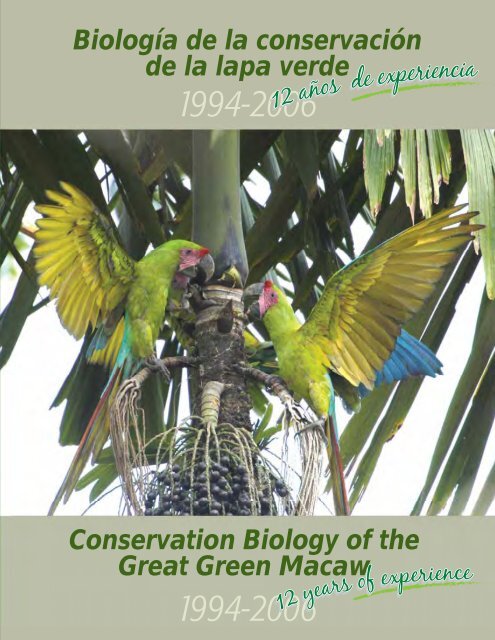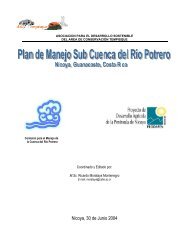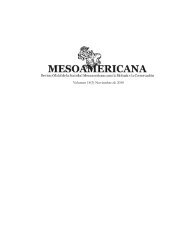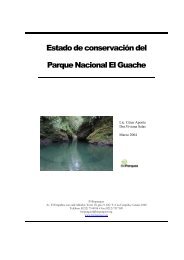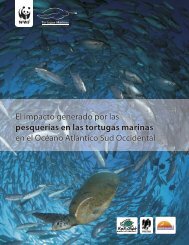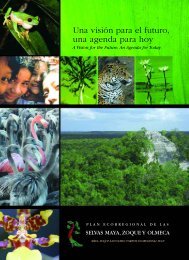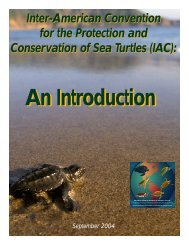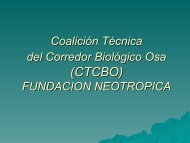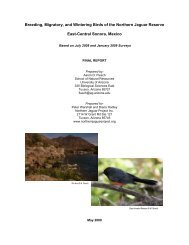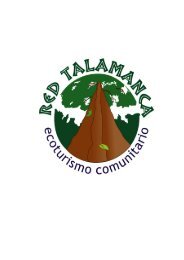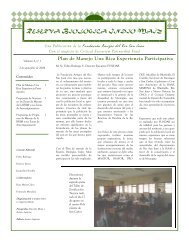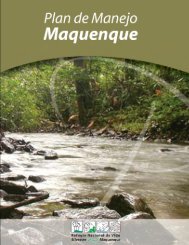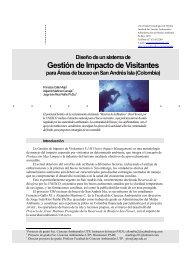1994-2006 - Eco-Index
1994-2006 - Eco-Index
1994-2006 - Eco-Index
You also want an ePaper? Increase the reach of your titles
YUMPU automatically turns print PDFs into web optimized ePapers that Google loves.
Biología de la conservación<br />
de la lapa verde<br />
<strong>1994</strong>-<strong>2006</strong><br />
Conservation Biology of the<br />
Great Green Macaw<br />
<strong>1994</strong>-<strong>2006</strong><br />
experience<br />
of years 12<br />
12 years of experience
Credits<br />
Créditos<br />
Este documento debe de citarse / This document must be quoted as:<br />
CHASSOT Olivier, MONGE Guisselle, POWELL George<br />
Biología de la conservación de la lapa verde (<strong>1994</strong>-<strong>2006</strong>), 12 años de<br />
experiencia. Conservation Biology of the Great Green Macaw (<strong>1994</strong>-<br />
<strong>2006</strong>), 12 Years of Experience.<br />
San Pedro, Costa Rica: Centro Científico Tropical, <strong>2006</strong>, 12 p.<br />
Publicado con el apoyo de / published with support from:<br />
Fotografías / Pictures:<br />
Mark Stafford, Guillermo Durán<br />
2
Biología de la conservación de la lapa verde, 12 años de experiencia<br />
<strong>1994</strong>-<strong>2006</strong><br />
LA LAPA VERDE<br />
La lapa verde (Ara<br />
ambiguus) tiene una distribución<br />
limitada en tierras<br />
bajas húmedas del<br />
Atlántico de Centroamérica<br />
desde Honduras hasta el<br />
norte de Colombia, con<br />
una población aislada en el<br />
Pacífico en Esmeraldas y<br />
Guayaquil, Ecuador. En<br />
Costa Rica, su rango de<br />
anidamiento se limita<br />
actualmente a aproximadamente<br />
600 km 2 de bosque<br />
tropical muy húmedo del<br />
país, en la zona fronteriza con Nicaragua al norte. Esta majestuosa<br />
ave en peligro de extinción depende altamente del<br />
almendro de montaña (Dipteryx panamensis) para alimentarse<br />
y para anidar.<br />
EL PROYECTO<br />
El Proyecto de Investigación y Conservación de la Lapa<br />
Verde fue iniciado por el Dr. George V. N. Powell y se dedica<br />
desde <strong>1994</strong> al estudio de la biología de conservación de la<br />
lapa verde en el norte de Costa Rica y posee la base de datos<br />
biológicos más importante sobre esta especie. El Proyecto se<br />
beneficia del respaldo administrativo del Centro Científico<br />
Tropical desde 1997. La preocupación del Dr. Powell era bien<br />
acertada cuando la primera fase del estudio determinó que<br />
el área de distribución de la lapa verde en Costa Rica se<br />
había reducido en un 90% desde principios del Siglo XX.<br />
Con los estudios preliminares se pudo comprobar que la<br />
distribución limitada de la lapa verde, en combinación con<br />
su dependencia a un complejo arreglo de recursos alimenticios<br />
implicaba que la protección de su hábitat y recursos<br />
beneficiaría a una multitud de otras especies de los bosques<br />
donde la lapa vive. La capacidad de esta especie de ejercer<br />
un “efecto sombrilla” para la flora y fauna del hábitat que<br />
ocupa, hace que estudiarla sea de importancia crítica para<br />
establecer prioridades de conservación, ya que la zona no<br />
contaba con ninguna área protegida importante. La Zona<br />
Norte ha sufrido la tasa de deforestación más alta del país en<br />
las décadas de los ochenta y noventa, dejando menos de un<br />
30% del bosque en pie. Sin embargo, varios estudios científicos<br />
resaltan el alto nivel de biodiversidad de los bosques<br />
donde habita la lapa verde, entre los más diversos de<br />
Centroamérica.<br />
En los primeros años de estudio, estimamos la población<br />
de lapa verde en 35 parejas reproductivas. Nuestras lapas<br />
cuentan con la Reserva Biológica Indio-Maíz en Nicaragua,<br />
donde ellas encuentran un extenso hábitat propicio a su<br />
desarrollo. Sin embargo, se hacen cada día más frecuentes<br />
las incursiones de madereros costarricenses al otro lado del<br />
Río San Juan, así que esta reserva, una de las más importantes<br />
de Centroamérica, tampoco está a salvo de las motosierras.<br />
Hoy día, nuestra población de lapa verde se encuentra<br />
en un estado muy precario y muy frágil, en el cual la<br />
menor modificación de sus condiciones de vida puede llevarla<br />
a la extinción.<br />
RESULTADOS DE LA INVESTIGACIÓN<br />
Antes de este estudio, poco se sabía acerca de la ecología<br />
de la lapa verde. Se pensaba que migraban estacionalmente<br />
y utilizaban una variedad de hábitats en diferentes altitudes,<br />
su nido no estaba descrito por los científicos y su principal<br />
hábitat y fuentes de alimento estaban escasamente identificados.<br />
El objetivo de este estudio fue recopilar información<br />
básica sobre el hábitat de las lapas y sus requerimientos<br />
espaciales, con el fin de establecer prioridades para la conservación<br />
de hábitat suficiente que sustentará a una<br />
población viable de lapa verde en los bosques húmedos de<br />
tierras bajas en Costa Rica.<br />
Una investigación preliminar inició en 1993; y un proyecto<br />
completo de investigación con radio-telemetría fue iniciado<br />
en <strong>1994</strong> y continuado hasta 2000. La telemetría nos permitió<br />
determinar rangos hogareños y el uso de hábitat por<br />
las lapas. Adicionalmente monitoreamos el estado de todos<br />
los nidos conocidos o posibles y colectamos información<br />
sobre las características de los nidos. Finalmente, estudiamos<br />
la fenología de las especies arbóreas de las que se ha<br />
descubierto que forman parte de la dieta de las lapas.<br />
Nuestra extensa base de datos incluye información sobre:<br />
• Rango reproductivo en Costa Rica<br />
• Información general sobre anidamiento<br />
• Sitios de anidamiento<br />
• Fidelidad para los nidos<br />
• Defensa de la fuente de anidamiento<br />
• Productividad de nidos
• Primer año de sobreviviencia para juveniles<br />
• Población no reproductiva<br />
• Patrones de migración<br />
• Conducta de forrajeo<br />
EL PLAN DE CONSERVACIÓN<br />
La sobrevivencia de la lapa verde depende de la disponibilidad<br />
de un hábitat adecuado e intacto, razón por la cual<br />
en conjunto con varios actores locales y nacionales propusimos<br />
en el año 1998 la implementación de un plan de conservación<br />
que podría proteger suficiente hábitat para mantener<br />
una pequeña y sana población reproductiva en Costa<br />
Rica. Este audaz plan de conservación integral se conoce<br />
ahora como “Corredor Biológico San Juan-La Selva”, e<br />
incluye la creación del “Refugio Nacional de Vida Silvestre<br />
Mixto Maquenque” en 2005, con una superficie de 54,000<br />
ha de ecosistema natural abarcando el área de anidamiento<br />
de la lapa verde.<br />
En este sentido logramos restringir o prohibir el<br />
aprovechamiento industrial del bosque en la zona crítica de<br />
anidamiento de la lapa verde y vedar parcialmente la corta<br />
del almendro. En pro de un desarrollo sostenible de la Zona<br />
Norte y para la conservación de la lapa verde animamos a los<br />
finqueros a explotar en forma sostenible sus bosques por<br />
medio de la extracción de productos no maderables tales<br />
como plantas medicinales, frutas y semillas y apoyar las<br />
alternativas de reforestación sostenible con especies nativas<br />
maderables que beneficien a la lapa verde, a través de un<br />
Pago de Servicio Ambiental económicamente favorable a<br />
estos tipos de proyecto.<br />
Para enfrentar el saqueo de nidos, desarrollamos al inicio<br />
del proyecto un programa intensivo de educación<br />
ambiental durante 18 meses en las comunidades de la<br />
zona de influencia.<br />
EL CORREDOR BIOLÓGICO<br />
La zona de bosque tropical atlántico húmedo del norte<br />
de Costa Rica mantiene el único hábitat viable de llanura<br />
capaz de mantener la continuidad del Corredor Biológico<br />
Mesoamericano entre Costa Rica y Nicaragua, la brecha más<br />
grande en la ruta del Corredor entre Honduras y Colombia.<br />
El Corredor Biológico San Juan-La Selva (246.608 ha) promueve<br />
la restauración y conexión entre remanentes de<br />
bosque de la Cordillera Volcánica Central y la Estación<br />
Biológica La Selva (125.691 ha) en el norte de Costa Rica,<br />
unidos con el Refugio Nacional de Vida Silvestre Barra del<br />
Colorado (102.165 ha) y el Parque Nacional Tortuguero<br />
(29.068 ha) en la costa caribeña de Costa Rica. Al mismo<br />
tiempo, la conexión se torna sinérgicamente más importante<br />
con el extenso complejo que incluye la Reserva<br />
Biológica Indio-Maíz (306.980 ha), Punta Gorda (54.900<br />
ha) y Cerro Silva (339.400 ha) en el Sureste de Nicaragua.<br />
El Corredor Biológico San Juan-La Selva consolidará estas<br />
seis áreas protegidas en una sola unidad biológica que<br />
suma 1.204.812 ha.<br />
La unidad de conservación central del Corredor Biológico<br />
San Juan-La Selva es el Refugio Nacional de Vida Silvestre<br />
Mixto Maquenque, ubicado al sur de la Reserva Indio-Maíz y<br />
colindando con el límite oeste de Barra del Colorado. Esta<br />
nueva área protegida conserva la porción del corredor con el<br />
porcentaje más alto de cobertura forestal. El bosque tropical<br />
húmedo del Atlántico, contenido dentro de la propuesta del<br />
Corredor y las áreas protegidas que conecta, son biológicamente<br />
diversas, albergando<br />
un estimado de 6.000<br />
(36) especies de plantas<br />
vasculares (número de<br />
especies vulnerables y en<br />
peligro de extinción entre<br />
paréntesis), 139 (32)<br />
especies de mamíferos,<br />
515 (64) aves, 135 (35)<br />
reptiles y 80 (45) anfibios.<br />
LA ALIANZA<br />
El Comité Ejecutivo del<br />
Corredor Biológico San<br />
Juan-La Selva se formó oficialmente<br />
en marzo del 2001 como resultado de una alianza<br />
entre el Centro Científico Tropical, la Sociedad para la<br />
Conservación de la Vida Silvestre, la Organización para<br />
Estudios Tropicales, el Corredor Biológico Mesoamericano, el<br />
Proyecto de Investigación y Conservación de la Lapa Verde,<br />
la Asociación para el Bienestar Ambiental de Sarapiquí, la<br />
Asociación Preservacionista de Flora y Fauna Silvestre, la<br />
Asociación para la Conservación y el Manejo Forestal de San<br />
Carlos, Amigos de la Lapa Verde, la Asociación de<br />
Voluntariado, Investigación y Desarrollo Ambiental, el Centro<br />
de Derecho Ambiental y de los Recursos Naturales, la<br />
Comisión de Desarrollo Forestal de San Carlos, el Área de<br />
Conservación Arenal Huetar Norte, el Área de conservación<br />
Cordillera Volcánica Central, la Reserva Biológica La<br />
Tirimbina, la Municipalidad de San Carlos y la Municipalidad<br />
de Sarapiquí. Así mismo, en el 2002, se crea la Oficina Local<br />
del Corredor Biológico San Juan-La Selva en Puerto Viejo de<br />
Sarapiquí, a cargo de ABAS. El Comité tiene su sede en el<br />
CCT, en San Pedro de Montes de Oca, San José, y asume la<br />
responsabilidad de coordinar y promover la implementación<br />
del Corredor.<br />
Cada una de estas organizaciones tiene responsabilidades<br />
definidas en el seno del Comité Ejecutivo del<br />
Corredor.<br />
4
LAS ALTERNATIVAS<br />
El territorio del Refugio Nacional de Vida silvestre Mixto<br />
Maquenque es el área de conservación principal dentro del<br />
Corredor; es considerado como la prioridad más alta. Tres<br />
áreas de prioridad intermedia constituyen los “núcleos” del<br />
Corredor; el territorio remanente comprende la matriz del<br />
Corredor. El objetivo de la iniciativa del corredor es la preservación<br />
del 100% del hábitat de los núcleos y 50% de la<br />
matriz mediante el Pago por Servicios Ambientales dirigido a<br />
propietarios privados.<br />
Estos incentivos<br />
financieros influyen<br />
fuertemente en las tendencias<br />
de uso de la tierra<br />
en esta región y se ampliarán<br />
con mayor promoción<br />
para aumentar la participación<br />
de dueños de<br />
tierras a una escala mayor<br />
y con criterios de conectividad<br />
biológica, como<br />
requisito para desarrollar<br />
el corredor.<br />
La creación de Maquenque generará fuentes de empleo<br />
en un área económicamente pobre que depende actualmente<br />
de actividades forestales y agrícolas limitadas. Las<br />
servidumbres ecológicas han demostrado ser medidas efectivas<br />
para lograr la conservación de lugares escénicos de<br />
interés turístico en Costa Rica y se podrán utilizar en los<br />
núcleos y en la matriz del corredor.<br />
Las poblaciones de Costa Rica y Nicaragua se están concienciando<br />
más sobre la conservación ambiental; especies<br />
como el manatí y la lapa verde son parte de su legado natural<br />
nacional. El programa de educación ambiental enseña a<br />
los alumnos cómo los esfuerzos de conservación que preservan<br />
y conectan los hábitats aislados pueden apoyar la protección<br />
de tales especies de importancia nacional. Además,<br />
la iniciativa trabaja una estrategia de desarrollo de ecoturismo<br />
comunitario asociada a la implementación de la “Ruta de<br />
Aves del Corredor Biológico San Juan-La Selva”.<br />
Todo el proceso del Corredor es impulsado por el Comité<br />
Ejecutivo del Corredor Biológico San Juan-La Selva, con el<br />
apoyo del Centro Científico Tropical en la coordinación y<br />
administración de recursos. El Comité está integrado por una<br />
alianza de 20 instituciones.<br />
NICARAGUA-COSTA RICA<br />
En Nicaragua y Costa Rica, grandes extensiones de<br />
bosques se encuentran amenazadas por la rápida extracción<br />
forestal que ocurre tanto en la zona de amortiguamiento de<br />
Indio-Maíz como en la zona norte de Costa Rica. En estas<br />
zonas, los madereros se aprovechan de la ausencia de una<br />
política de desarrollo integral y de mecanismos que aseguran<br />
el manejo racional de los recursos forestales.<br />
El proceso de colaboración entre Costa Rica y Nicaragua<br />
en el tema ambiental es el resultado de varios talleres para<br />
construir un modelo integrado que inició en los años ochenta<br />
con la iniciativa SI-A-PAZ (Sistema Internacional de Áreas<br />
Protegidas para la Paz). En abril 1999, se creó la Reserva de<br />
la Biosfera del Sureste de Nicaragua.<br />
En el 2000 y 2001, el Programa de las Naciones Unidas<br />
para el Desarrollo (PNUD) ha venido fomentando encuentros<br />
binacionales entre instituciones nicaragüenses y costarricenses,<br />
conformando una red de grupos de trabajo de los<br />
sectores ambientales, académicos, culturales y mediáticos. A<br />
partir del 2001, el Corredor Biológico Mesoamericano ha<br />
apoyado experiencias de colaboración binacional originadas<br />
desde el proceso de SI-A-PAZ, los cuales condujeron a la<br />
identificación del Corredor Biológico Binacional El Castillo-<br />
San Juan-La Selva, donde la lapa verde, especie emblemática,<br />
se desenvuelve y se reproduce.<br />
La campaña binacional “Salvemos la Lapa Verde” se realiza<br />
desde 2001 en conjunto con Fundación del Río y el<br />
Centro Científico Tropical, en Nicaragua y Costa Rica respectivamente.<br />
La experiencia de la coordinación de los esfuerzos<br />
binacionales enseña que las áreas protegidas de<br />
Nicaragua y Costa Rica mantienen un vínculo biológico y<br />
social evidente en la cuenca del Río San Juan. A mediados<br />
del 2002, decidimos fortalecer la identificación de actores<br />
con acciones concretas, como fue el caso, por ejemplo, de la<br />
cristalización sobre el tema de la lapa verde: se realizaron<br />
once talleres binacionales sobre la biología y conservación<br />
de la lapa verde en Nicaragua y cinco festivales binacionales.<br />
Esta colaboración produjo muchos frutos en la zona de<br />
amortiguamiento de la Reserva Biológica Indio-Maíz. Este<br />
proceso conduce a la creación de la Comisión Binacional del<br />
Corredor Biológico El Castillo-San Juan-La Selva en noviembre<br />
2002, la cual está integrada por agencias de los<br />
Gobiernos, Municipios y ONGs de ambos países, con el fin<br />
de articular las acciones binacionales que hasta la fecha se<br />
desarrollaban de manera conjunta pero informalmente.<br />
Nuestra aventura para conservar la metapoblación de<br />
lapa verde y el hábitat que esta magnifica ave representa se<br />
orienta claramente hacia el fortalecimiento de los nexos de<br />
colaboración entre Nicaragua y Costa Rica.<br />
5
Responsabilidades de las organizaciones del Comité Ejecutivo<br />
6
12 Years of Conservation Biology of the Great Green Macaw<br />
<strong>1994</strong>-<strong>2006</strong><br />
THE GREAT GREEN MACAW<br />
The great green<br />
macaw (Ara ambiguus)<br />
has a limited distribution<br />
in the Atlantic wet lowlands<br />
of Central America,<br />
from Honduras south to<br />
northern Colombia, with<br />
a small isolated population<br />
in the Pacific in<br />
Esmeraldas and<br />
Guayaquil, Ecuador. In<br />
Costa Rica, this species is currently limited to approximately<br />
600 km 2 of tropical very wet forest in the northern part<br />
of the country, in the border area with Nicaragua. It highly<br />
depends on the Almendro tree (Dipteryx panamensis) both<br />
for feeding and nesting substrate. This endangered species,<br />
which is listed in Appendix I of CITES, is in serious danger<br />
of disappearing from Costa Rica in the near future.<br />
THE PROJECT<br />
The Great Green Macaw Research and Conservation<br />
Project was launched in <strong>1994</strong> by Dr. George V. N. Powell and<br />
aims to study the conservation biology of the great green<br />
macaw in northern Costa Rica and has developed the major<br />
biological data base on this species. The project is administered<br />
by the Tropical Science Center since 1997. The concerns<br />
of Dr. Powell were supported by the project's first-year<br />
findings that the nesting range of these macaws in Costa<br />
Rica had already been reduced by 90% since the early XX<br />
Century.<br />
Preliminary studies found that the great green macaw's<br />
limited distribution and relatively large home range, combined<br />
with its dependence on a complex array of food<br />
resources implied that the protection of its habitat and<br />
resources would benefit a multitude of other species that<br />
reside in these lowland wet forests. Due to the fact the study<br />
site was lacking an important protected area, the potential of<br />
this species as an "umbrella species" for the fauna and flora<br />
of the habitat where it thrives makes it a critical key species<br />
to study in order to set up conservation priorities. The<br />
Northern Zone had suffered the highest deforestation rate in<br />
the country over the eighties and nineties, leaving less than<br />
30% of the original forest standing. Nevertheless, several<br />
studies have found that the forests in this region still maintain<br />
a high species diversity which is among the most diverse<br />
in Central America.<br />
In the first years of the study, we estimated the great<br />
green macaw population in Costa Rica to be approximately<br />
35 reproductive pairs. Our great green macaw population of<br />
Costa Rica depends on the more extensive habitat and presumably<br />
larger macaw population in the Indio-Maíz<br />
Biological Reserve in Nicaragua. Nevertheless, logging incursions<br />
across the San Juan River into the Indio-Maíz are<br />
increasingly common, and even this reserve, Central<br />
America's most important, is not safe from the chainsaws.<br />
Today, our great green macaw population is already in a precarious<br />
and fragile condition, and the loss of remaining forest<br />
habitat in northern Costa Rica or southern Nicaragua may<br />
push it to regional, if not global, extinction.<br />
RESEARCH RESULTS<br />
At the onset of this project, little was known about the<br />
ecology of the great green macaw. While it was thought to<br />
migrate seasonally and use a variety of habitats at different<br />
elevations, its nest had not been described by scientists, and<br />
its primary habitat and food sources were largely unidentified.<br />
The objective of our research, therefore, was to compile<br />
basic data on the macaws' habitat and spatial requirements<br />
in order to set priorities for the conservation of sufficient<br />
habitat to support a viable population of great green macaws<br />
in Costa Rica.<br />
Preliminary research on the great green macaw began in<br />
1993; a full research project was initiated in <strong>1994</strong> and has<br />
continued through 2002. We used radio-telemetry to determine<br />
macaw home ranges and habitat use. In addition, we<br />
have monitored the status of all known or suspected nest<br />
sites and collected data on nest site characteristics. Finally,<br />
we studied the fruiting phenology of tree species that were<br />
discovered to form part of the macaws' diet.<br />
Our extensive data base includes information on:<br />
• Breeding Range in Costa Rica<br />
• General Nesting Data<br />
• Nest Sites<br />
• Nest Fidelity<br />
• Defense of Nesting Resource<br />
• Nest Productivity<br />
• First-Year Survival of Juveniles<br />
• Non-nesting Population<br />
• Migration Patterns<br />
• Foraging Behavior<br />
7
THE CONSERVATION PLAN<br />
The survival of the great green macaw depends on the<br />
availability of adequate, intact forest habitat. For this reason,<br />
together with local and national stakeholders, we proposed<br />
in 1998 the implementation of a conservation plan that<br />
could protect enough habitat to maintain a small and viable<br />
breeding population in Costa Rica. This integral conservation<br />
plan is known now as “San Juan-La Selva Biological<br />
Corridor”, and included the creation in 2005 of the<br />
“Maquenque National Wildlife Refuge”, with an extension of<br />
54,000 ha of natural ecosystems embracing the breeding<br />
range of the great green macaw.<br />
With this perspective, we managed to restrict or prohibit<br />
the cutting of forest in the critical nesting zone of the macaw<br />
as well as to partially prohibit the harvest of almendro. To<br />
promote sustainable development in the Northern Zone and<br />
the conservation of the great green macaw, we encourage<br />
local farmers and communities to manage their lands in a<br />
sustainable manner by way of the extraction of non-timber<br />
products such as medicinal plants, fruits and seeds and to<br />
support reforestation initiatives with native trees that are<br />
both commercially important and benefit the great green<br />
macaw through incentives from the Government.<br />
To resolve nest poaching, we developed an intensive<br />
environmental education program at the beginning of the<br />
Project for 18 months in different communities within the<br />
influence area.<br />
THE BIOLOGICAL CORRIDOR<br />
The zone of humid Atlantic tropical forest of the north of<br />
Costa Rica maintains the only viable lowland habitat able to<br />
maintain the continuity of the Mesoamerican Biological<br />
Corridor between Costa Rica and Nicaragua, the greatest<br />
breach in the route of the corridor between Honduras and<br />
Colombia. The San Juan-La Selva Biological Corridor<br />
(246.608 ha) promotes restoration and preserves the connections<br />
between remnants of forest in the Central Volcanic<br />
Mountain range and the La Selva Biological Station (125.691<br />
has) in the north of Costa Rica, united with the Barra del<br />
Colorado National Wildlife Refuge (102.165 ha) and<br />
Tortuguero National Park (29.068 ha) in the Caribbean coast<br />
of Costa Rica. At the same time, the connection becomes<br />
more important with the extensive conservation complex<br />
that includes Indio-Maíz Biological Reserve (306.980 ha),<br />
Punta Gorda (54.900 ha) and Cerro Silva (339.400 ha) in<br />
Southeastern Nicaragua. The San Juan-La Selva Biological<br />
Corridor will consolidate these six protected areas into a single<br />
biological unit, which sums up 1.204.812 ha.<br />
The central conservation unit of the San Juan-La Selva<br />
Biological Corridor is the Maquenque Mixed National<br />
Wildlife Refuge, located to the south of Indio-Maíz<br />
Biological Reserve and contiguous with the westernmost<br />
limits of Barra del Colorado. This new protected area will<br />
conserve the corridor portion with the highest percentage<br />
of forest cover. The humid tropical forest of the Atlantic<br />
included within the proposed protected biological corridor<br />
and adjacent protected areas that will be connected, are<br />
biologically diverse, considered the home of 6.000 (36)<br />
species of vascular plants (number of vulnerable and<br />
endangered species between parenthesis), 139 (32)<br />
species of mammals, 515 (64) birds, 135 (35) reptiles and<br />
80 (45) amphibians.<br />
THE ALLIANCE<br />
The Executive<br />
Committee of the San<br />
Juan-La Selva Biological<br />
Corridor was officially<br />
formed in March 2001 as<br />
a result of an alliance<br />
between the Tropical<br />
Science Center, the<br />
Wildlife Conservation<br />
Society, the Organization<br />
for Tropical Studies, the<br />
Mesoamerican Biological<br />
Corridor-Costa Rica, the<br />
Great Green Macaw<br />
Research and Conservation Project, the Association for<br />
Environmental Welfare of Sarapiquí, the Association for the<br />
Preservation of Flora and Wildlife, the Association for the<br />
Management of Forest Areas of San Carlos, Friends of the<br />
Great Green Macaw, The Association of Volunteer Research<br />
and Environmental Development, the Center for<br />
Environmental Rights and Natural Resources, the<br />
Commission for Forestry Development of San Carlos, the<br />
Arenal Huetar Norte Conservation Area, the Central<br />
Volcanic Range Conservation Area, La Tirimbina Biological<br />
Reserve, the Municipality of San Carlos and the Municipality<br />
of Sarapiquí. Likewise, in 2002, the Local Office of the San<br />
Juan-La Selva Biological Corridor was created in Puerto<br />
Viejo and soon will be operated by the Ministry of the<br />
Environment from Boca Tapada at the outskirts of<br />
Maquenque National Wildlife Refuge. The Committee has<br />
its headquarters at the Tropical Science Center, in San<br />
Pedro de Montes de Oca, San José, and assumes the<br />
responsibility of coordinating and promoting the implementation<br />
of the corridor and its main components.<br />
8
Each organization has clearly defined responsibilities within the Executive Committee of the Corridor.<br />
Responsabilities of Executive Committee Organizations<br />
THE ALTERNATIVE<br />
Territory for Maquenque Mixed National Wildlife Refuge,<br />
the principal conservation area within the Corridor, is considered<br />
highest priority. Three tracts of intermediate priority<br />
constitute the Corridor “nuclei”, the remaining territory comprising<br />
the Corridor matrix. The goal of the Corridor initiative<br />
is to preserve 100% of nuclei and 50% of matrix habitat via<br />
environmental service payments to private landowners. Such<br />
financial incentives strongly influence land use trends in this<br />
region and will be expanded and better publicized to foster<br />
landowner participation at larger, more biologically relevant<br />
scales required to implement the Corridor.<br />
The creation of Maquenque will generate employment<br />
opportunities in an economically depressed area that currently<br />
depends on limited forestry and agricultural activities.<br />
Conservation easements have also proven to be an effective<br />
measure for the conservation of scenic locations of touristy<br />
value in Costa Rica and will be used in the Corridor nuclei<br />
and in the Corridor matrix<br />
Costa Rican and Nicaraguan people are becoming<br />
increasingly aware, and species such as the manatee and<br />
great green macaw are part of their national heritage. The<br />
environmental education program will inform schoolchildren<br />
how conservation efforts that preserve and connect habitats<br />
can help protect such species of national importance.<br />
Furthermore, the initiative works on a community-based<br />
ecotourism development strategy enhanced by the implementation<br />
of the “San Juan-La Selva Birding Route”.<br />
The Corridor initiative is led by the San Juan-La Selva<br />
Biological Corridor Executive Committee with the participation<br />
of the Tropical Science Center (TSC) as the coordinator<br />
and resource manager. The committee is comprised of an<br />
alliance of institutions.<br />
9
NICARAGUA-COSTA RICA<br />
In Nicaragua and Costa Rica, great extensions of pristine<br />
and partly intervened forests are threatened by the fast logging<br />
that happens as much in the buffer zone of the Indio-<br />
Maíz Biological Reserve as in northern Costa Rica. In these<br />
areas, the forest industry takes advantage of the absence of<br />
policy for an integral development and mechanisms that<br />
warrant the sustainable management of forest resources.<br />
The environmental<br />
partnership between<br />
Costa Rica and Nicaragua<br />
is the result of various<br />
workshops held to build<br />
an integrated model that<br />
initiated in the eighties<br />
with the SI-A-PAZ initiative<br />
(International System of<br />
Protected Areas for<br />
Peace). In April 1999, the<br />
Biosphere Reserve of<br />
Southeast Nicaragua was<br />
created.<br />
In 2000 and 2001, The United Nations Program for<br />
Development (UNPD) facilitated bi-national meetings<br />
amongst Nicaraguan and Costa Rican institutions, establishing<br />
a working network of the environmental, academic, cultural<br />
and media sectors from both countries. Since 2001, the<br />
Mesoamerican Biological Corridor has supported bi-national<br />
collaborative experiences originated since the SI-A-PAZ<br />
process, which led to the identification of the El Castillo-San<br />
Juan-La Selva Biological Corridor, where the great green<br />
macaw, flagship species for these territories, thrives and<br />
reproduces.<br />
The bi-national campaign “Save the Great Green Macaw”<br />
is being implemented since 2001 together with Fundación<br />
del Río and the Tropical Science Center, in Nicaragua and<br />
Costa Rica respectively. This bi-national experience teaches<br />
us that Nicaraguan and Costa Rican protected areas maintain<br />
a clear biological and social relationship within the San Juan-<br />
La Selva basin. In 2002, we worked on building these links.<br />
By mid 2002, we decided to strengthen the identification of<br />
stakeholders by the way of specific actions. Such was the<br />
case, for example, of the crystallization on the topic of the<br />
Great Green Macaw: eleven workshops about the biology<br />
and conservation of the great green macaw were held in<br />
Nicaragua and five bi-national festivals were organized. This<br />
partnership produced many outreach in the buffer zone of<br />
Indio-Maíz Biological Reserve. This process led to the creation<br />
of the Bi-national Commission of the El Castillo-San<br />
Juan-La Selva Biological Corridor in November 2002, which<br />
is integrated by government agencies, local governments<br />
and NGOs from both countries, with the aim to develop binational<br />
actions that had been conducted on an informal<br />
basis until then.<br />
Our endeavour to conserve the metapopulation of great<br />
green macaws and the habitat that this magnificent bird<br />
represents is clearly oriented towards the strengthening of<br />
collaborative links between Nicaragua and Costa Rica.<br />
Fideicomiso Maquenque<br />
Maquenque Trust<br />
Para fortalecer los componentes operativos y programáticos<br />
del Refugio Nacional de Vida Silvestre Mixto Maquenque<br />
y del Corredor Biológico San Juan-La Selva, canalizamos<br />
donaciones mediante el Fideicomiso Maquenque. Esto nos<br />
permitirá asegurar la protección de la lapa verde y su hábitat<br />
a largo plazo.<br />
Visítenos en www.maquenque.net.<br />
In order to strengthen the operative and programmatic<br />
components of Maquenque National Wildlife Refuge and<br />
San Juan-La Selva Biological Corridor, we channel donations<br />
through the Maquenque Trust. This will allow us to assure<br />
the protection of the great green macaws and their habitat<br />
on the long term.<br />
Visit us at www.maquenque.net.<br />
10
Time Line<br />
Escala Cronológica<br />
11
References<br />
Referencias<br />
CHASSOT Olivier, MONGE Guisselle, Corredor Biológico<br />
San Juan-La Selva. Ficha técnica. San José, Costa Rica:<br />
Centro Científico Tropical, 2001.<br />
CHASSOT Olivier, MONGE Guisselle, POWELL George,<br />
PALMINTERI Suzanne, ALEMAN Ulises, WRIGHT Pamela,<br />
ADAMEK Krista, Lapa verde, víctima del manejo forestal<br />
insostenible, Ciencias Ambientales 21, 2001.<br />
CHASSOT Olivier, MONGE Guisselle, RUIZ Antonio,<br />
MARISCAL Teresa, Acciones tico-nicas por la lapa verde en<br />
la cuenca del San Juan, Ambientico 105, 2002, 20-21.<br />
CHASSOT Olivier, MONGE Guisselle, RUIZ Antonio,<br />
MARISCAL Teresa, La lapa verde, orgullo de la Cuenca del<br />
Río San Juan. Managua, Nicaragua: Fundación del Río, 2002.<br />
CHASSOT Olivier, MONGE Guisselle, RUIZ Antonio,<br />
MARISCAL Teresa, Corredor Biológico Costa Rica-<br />
Nicaragua pro lapa verde, Ambientico 114, 2003, 21-23.<br />
CHASSOT Olivier, MONGE Guisselle, POWELL George,<br />
WRIGHT Pamela, PALMINTERI Suzanne, Corredor Biológico<br />
San Juan-La Selva. Un proyecto del Corredor Biológico<br />
Mesoamericano para la conservación de la lapa verde y<br />
su entorno. San José, Costa Rica: Centro Científico Tropical,<br />
2005.<br />
CHASSOT Olivier, MONGE Guisselle, RUIZ Antonio, VALE-<br />
RIO Luis, Ficha técnica binacional Corredor Biológico El<br />
Castillo-San Juan-La Selva, Nicaragua-Costa Rica.<br />
Managua, Nicaragua: SICA / CCAD / CBM, <strong>2006</strong>.<br />
CHASSOT Olivier, MONGE Guisselle, Conformación y<br />
coalición de la Comisión Local del Corredor Biológico San<br />
Juan-La Selva. San José, Costa Rica: Centro Científico<br />
Tropical, 2001.<br />
MONGE Guisselle, CHASSOT Olivier, WRIGHT Pamela,<br />
POWELL George, ADAMEK Krista, La lapa verde a un paso de<br />
la extinción, Ambientico 87, 2000, 4-5.<br />
MONGE Guisselle, CHASSOT Olivier, LÓPEZ Rocío,<br />
CHAVES Henry, Justificación biológica para la creación del<br />
propuesto Parque Nacional Maquenque. San José, Costa<br />
Rica: Corredor Biológico San Juan-La Selva / Centro Científico<br />
Tropical, 2002.<br />
MONGE Guisselle, CHASSOT Olivier, POWELL George,<br />
PALMINTERI Suzanne, Propuestas de conservación para el<br />
guacamayo ambiguo en Costa Rica, Quercus 196, 2002, 38-<br />
42.<br />
MONGE Guisselle, CHASSOT Olivier, POWELL George,<br />
PALMINTERI Suzanne, ALEMAN Ulises, WRIGHT Pamela,<br />
<strong>Eco</strong>logía de la lapa verde (Ara ambigua) en Costa Rica,<br />
Zeledonia 7 (2), 2003, 4-12.<br />
POWELL George, WRIGHT Pamela, GUINDON Carlos,<br />
ALEMAN Ulises, BJORK Robin, Results and<br />
Recommendations for the Conservation of the Great<br />
Green Macaw (Ara ambigua) in Costa Rica. Sarapiquí,<br />
Costa Rica: Centro Científico Tropical, 1999.<br />
SNYDER Noel, McGOWAN Philipp, GILARDI James, GRA-<br />
JAL Alejandro (Ed.), Parrots. Status Survey and<br />
Conservation Action Plan. Gland, Switzerland / Cambridge,<br />
UK: UICN, 2000.<br />
Von HORSTMAN Eric, HENDERSON Bob (Eds.), El papagayo<br />
de Guayaquil en Cerro Blanco. The Guayaquil<br />
Macaw in Cerro Blanco. Guayaquil, Ecuador: Fundación Pro<br />
Bosque, 2005.<br />
Ara ambiguus (Bechstein, 1811)<br />
Great Green Macaw (E)<br />
Ara de Buffon (F)<br />
Guacamayo Ambiguo, Lapa Verde, Guacamaya Verde (S)<br />
Großen Soldatenara (D)<br />
Red List Category + Criteria: EN A2cd + 3cd (IUCN, 2005)<br />
12
We would like to thank our supporters:<br />
Agradecemos a nuestros patrocinadores:<br />
• Act for Nature<br />
• Adelaide Zoological Garden<br />
• Fondo Canje de Deuda Canadá-Costa Rica / Canada-Costa Rica<br />
Debt Exchange<br />
• Conservation International / Critical <strong>Eco</strong>system Partnership Fund<br />
• Epo Film / ORF<br />
• GTZ<br />
• Lars Lepperhoff<br />
• Rosemary Low<br />
• Mesoamerican Biological Corridor<br />
• Natur Stiftung und Artenschutz<br />
• North of England Zoological Society / Chester Zoo<br />
• Parrots International<br />
• Rainforest Alliance<br />
• Rainforest Biodiversity Group<br />
• Selva Verde Lodge<br />
• Tropica Verde<br />
• Tropical Science Center<br />
• United Nations Program for Development-Costa Rica / Global<br />
Environment Facility<br />
• United States Fish & Wildlife Service<br />
• The World Parrot Trust<br />
• Wildlife Conservation Society<br />
• Zeus Comunicación<br />
• Zoo de Doué-la-Fontaine<br />
• Zoologische Gesellschaft für Arten und Populationsschutz e.V.<br />
Queremos agradecer también a Mark Stafford por<br />
dejarnos disfrutar de sus maravillosas fotografías y por revisar<br />
la versión en inglés de este documento.<br />
Gracias al Centro Científico Tropical por creer en nuestro<br />
proyecto y siempre apoyarnos.<br />
We also would like to thank Mark Stafford for letting us<br />
enjoying his wonderful pictures and for reviewing the English<br />
version of this document.<br />
Thanks to the Tropical Science Center for believing in our<br />
Project and always supporting us.<br />
Guisselle & Olivier<br />
Guisselle & Olivier<br />
13
Distribución de la Lapa Verde en Costa Rica<br />
Range of the Great Green Macaw in Costa Rica<br />
Guisselle Monge Arias & Olivier Chassot<br />
Proyecto de Investigación y Conservación Lapa Verde<br />
Great Green Macaw Research and Conservation Project<br />
Comité Ejecutivo del Corredor Biológico San Juan-La Selva<br />
Executive Committee of the San Juan-La Selva Biological Corridor<br />
Centro Científico Tropical • Tropical Science Center<br />
Apartado 8-3870-1000 San José, Costa Rica<br />
Tel: (++506) 253-3267 • Fax: (++506) 253-4963<br />
lapa@cct.or.cr<br />
www.lapaverde.or.cr


